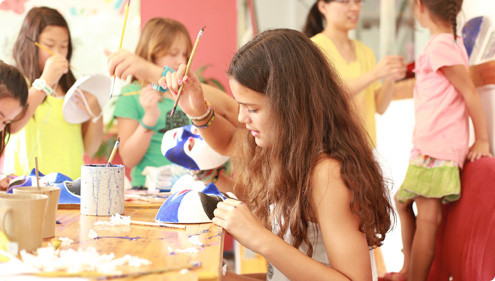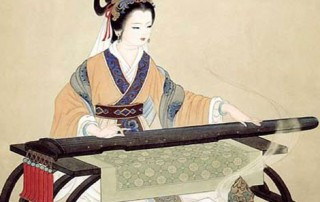Hutong School Cultural Activities: Ceramic Painting and Guqin Class
Whether you take part in our Internship Program or attend our Chinese classes, Hutong School organizes cultural activities several times a week for all its students and their friends. These events are the perfect opportunity to relax with friends, have some fun, find out more about Chinese culture and also spend some time with the Hutong School community.
Our cultural activities allow our students and interns to familiarize themselves with Chinese art, food and traditions to get a better overview of what makes this culture so unique. The range of our activities is extremely wide, from learning how to play board games like Mahjong or Weiqi to Kungfu lessons, and from acrobatic shows to cooking lessons!
Ceramic Painting: (瓷- cí)
 Ceramic painting, like all other Chinese customs and art forms, has a long history. We will not bother you with all the details, but in a nutshell: ceramic painting underwent big changes during the Han dynasty (206 B.C.-220 A.D.), even more details were introduced during the Six Dynasties (265-588 A.D.). The famous white and blue ceramic painting (as we now know it) appeared during the Yuan dynasty (1280-1367) and at the beginning of the Ming dynasty (1368-1643). Through history this art was under different influences such as the Islamic influence during the 16th century. During that same period, those ceramics were also copied or imitated in Europe. The ones from the Ming dynasty contain motifs like thunder patterns, traditional sceneries completed by poems, even Persian characters and the eight treasures, a Chinese religious motif incorporating the eight trigrams of the I Ching (these eight trigrams are an arranged octagonal around a symbol referring the balance of yin and yang).
Ceramic painting, like all other Chinese customs and art forms, has a long history. We will not bother you with all the details, but in a nutshell: ceramic painting underwent big changes during the Han dynasty (206 B.C.-220 A.D.), even more details were introduced during the Six Dynasties (265-588 A.D.). The famous white and blue ceramic painting (as we now know it) appeared during the Yuan dynasty (1280-1367) and at the beginning of the Ming dynasty (1368-1643). Through history this art was under different influences such as the Islamic influence during the 16th century. During that same period, those ceramics were also copied or imitated in Europe. The ones from the Ming dynasty contain motifs like thunder patterns, traditional sceneries completed by poems, even Persian characters and the eight treasures, a Chinese religious motif incorporating the eight trigrams of the I Ching (these eight trigrams are an arranged octagonal around a symbol referring the balance of yin and yang).
So, how does it work? Easy! You first need to paint your motif on unglazed white porcelain and then prepare your glaze. The following steps are about putting the correct amount and type of glaze and control the heat during the process. It is not that difficult when you have all the information, but be careful because sometimes the smallest detail can ruin your work.
Guqin Class: (古琴 – gǔqín)
 Because Chinese culture is mainly about art, we already experienced painting (traditional, ceramic), calligraphy, Chinese movies, traditional dishes and martial arts. However, for a full immersion you also need to experience and learn about the music. For this particular reason, Hutong School organized Guqin Classes to introduce this specific instrument to the students.The first Guqins were made around 3000 years ago; at that time they were way simpler and only got two to five strings. Because the skills of the player improved, the instrument evolved as well and counts now seven strings as most of the current instruments. Even the shape and the decoration changed from time to time. Back to the past, the Guqin was considered as a huge symbol of culture, the instrument is also related to other form of art such as poetry. Usually used as a solo instrument, the Guqin can be accompanied by the Xiao (a flute) or the Xun (an ocarina). The instrument was mostly played in intimate places or in beautiful spots where the beauty of the nature can match the emotion of the coming out of the instrument.
Because Chinese culture is mainly about art, we already experienced painting (traditional, ceramic), calligraphy, Chinese movies, traditional dishes and martial arts. However, for a full immersion you also need to experience and learn about the music. For this particular reason, Hutong School organized Guqin Classes to introduce this specific instrument to the students.The first Guqins were made around 3000 years ago; at that time they were way simpler and only got two to five strings. Because the skills of the player improved, the instrument evolved as well and counts now seven strings as most of the current instruments. Even the shape and the decoration changed from time to time. Back to the past, the Guqin was considered as a huge symbol of culture, the instrument is also related to other form of art such as poetry. Usually used as a solo instrument, the Guqin can be accompanied by the Xiao (a flute) or the Xun (an ocarina). The instrument was mostly played in intimate places or in beautiful spots where the beauty of the nature can match the emotion of the coming out of the instrument.
The first impression was kind of weird, for some of us it was the first time we saw this kind of instrument. We were not completely lost because the seven strings will remind you a guitar and some guitar players use their instruments in a similar way with a tapping technique. But the technique cannot be compared; it requires attention and a lot of practice to get it in the right way.
But after a few tries and good explanations from the teacher, you can already feel the difference and get a bit of the logic. It was a really nice immersion into this part of the Chinese culture, hearing the sound of the Guqin makes you think about the traditional China, and its beautiful scenery.
Luc Derouet
Marketing Assistant Intern